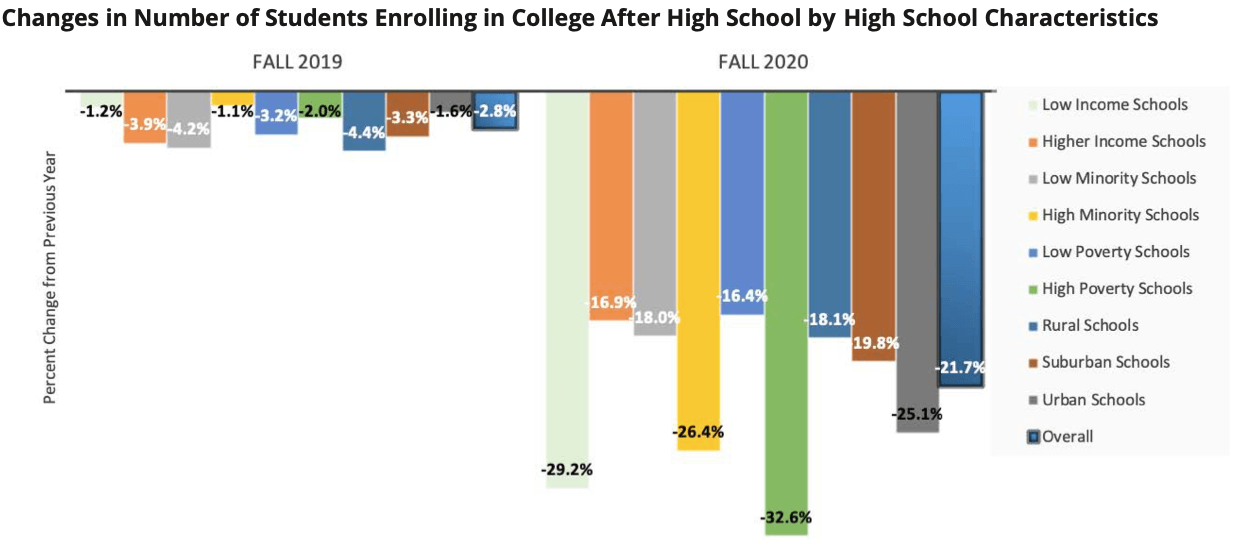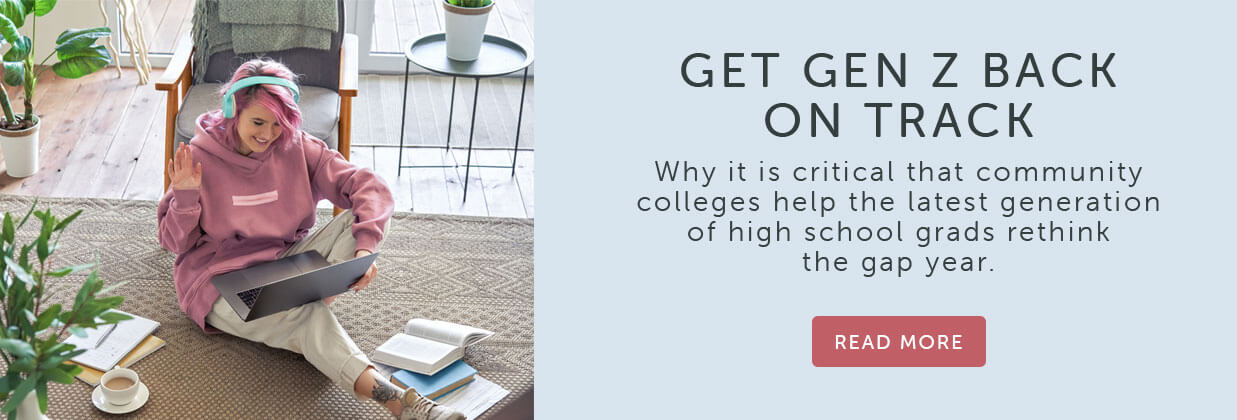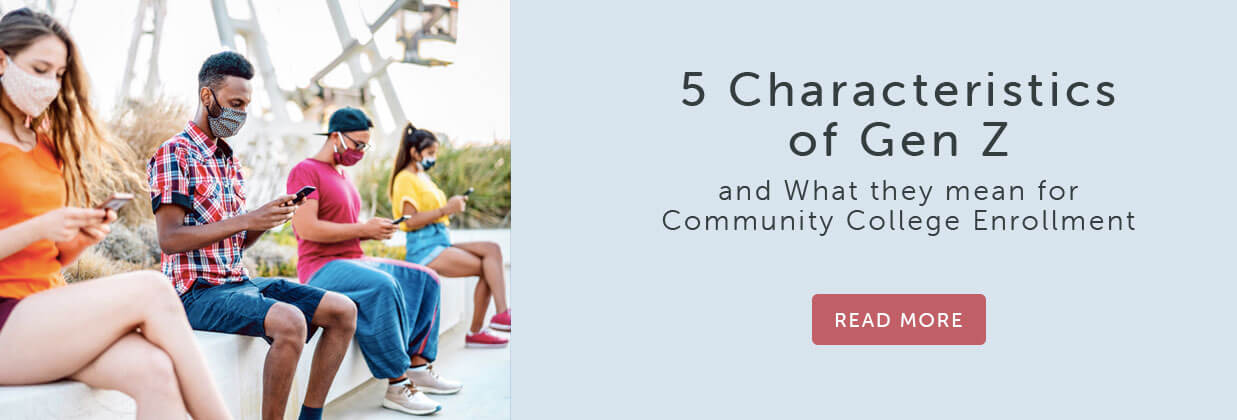The most recent generation of high school graduates is facing a changed educational landscape. How can community colleges help them make the smart choice?
In a year where the challenges of remote learning and the frequent openings and closures of college campuses have made almost daily headlines, it should come as no surprise to learn that those primarily affected by these closures—Gen Z—are taking a long, hard look at the educational choices ahead of them.
Gen Z, who comprise a cohort of students born between the late 1990s and mid 2010s, are the majority of those currently in the education system (save for very young students, graduate students, and older nontraditional students). Older members of Gen Z have graduated college and are just entering the workforce, while younger members of Gen Z are in middle school. This puts the bulk of Gen Z in either high school or college at a time when both are undergoing severe disruption.
With that in mind, it’s only right that community colleges step back and ask: how is Gen Z responding? Let’s take a closer look.
Gen Z is changing higher education.
While most members of Gen Z are still young, they are beginning to flex their economic muscles. It can be hard to spot definable trends about a generation until they’ve spent a few years as adults, making decisions for themselves. But with the oldest Gen Zers in their mid-twenties, there are several defining characteristics and trends about this generation which community colleges should know in order to understand how to best reach them—including factoring in the pandemic and how this is impacting their first few years in the job market or in college.
1. Gen Z is rethinking college.
Many of the college-going generation of Gen Z are unhappy with the way their institutions have handled the Covid-19 outbreak. Those who have spent a year doing remote learning while still paying full tuition fees are beginning to question whether this decision was the best—and those who have watched this happen are questioning whether they should make the same choices. As a result, many members of Gen Z are taking some time off as they reconsider their choices. Taking a “gap year” was a trend once popular for young people to take a year off between high school and college to travel. Instead of traveling, the 2020 gap year was used more to regroup and weigh education and career options.
2. Gen Z contributed most to the sharp drop in enrollment in 2020.
According to a December 2020 analysis by the National Student Clearinghouse Research Center, students enrolling in college immediately after high school fell 21.7 percent, or eight times the pre-pandemic rate in 2019. But the drop isn’t equal across the board: income continues to play the most significant role in enrollment declines for young people. There was a 29.2 percent drop in college enrollment for low-income high school grads, compared to 16.9 percent of higher-income high school grads. [1]

Source: National Student Clearinghouse Research Center [1] https://nscresearchcenter.org/wp-content/uploads/2020_HSBenchmarksReport.pdf
3. Gen Z is rethinking their careers.
The recent layoffs caused by the pandemic have disproportionately affected Gen Z, who, as the newest members of the workforce, were the easiest to lay off. Those who are in industries that have been hit hard and may be slow to recover are already questioning whether they should pivot early, and find a more stable career path while they have plenty of time to do so. Unemployment for young people (defined by the Organization for Economic Cooperation and Development as under 25) increased from 7.8% in February 2020 to 24.9% by May 2020 in the United States. Global unemployment numbers reflected similar trends from country to country. Many young people have taken jobs in the gig economy (think Instacart, DoorDash, Grubhub) and the service sector (as cashiers, clerks, or personal shoppers) to help families stay afloat and chip into their household income as worker displacement increased throughout 2020. [2, 3]
4. Gen Z is still concerned about how colleges are handling Covid-19.
Even though a vaccine is on the way, the majority of Gen Z is rightfully still worried a year later about how colleges are responding and adapting to the ongoing pandemic. One study found that over a third of respondents “strongly agree” that potential enrollees are very concerned about how colleges are dealing with the virus, and nearly half “agree.” Since community colleges have been at the forefront of offering flexible online classes, they are also in the best position to capture a section of wary Gen Z-ers to enrolling and studying from home as plans evolve.
What does this mean for marketers?
It’s clear given these statistics that community colleges can no longer rely on Gen Z to enroll in the same numbers as previous generations. In the past, community colleges could expect a steady percentage of high school graduates to enroll in their two-year programs. This is no longer the case and has only been compounded by the chaos of 2020. Community colleges have to commit to marketing to this demographic—especially the underserved, low-income section—in order to impact enrollment trends.
For one, community colleges need these enrollees in order to remain financially stable. Without this demographic continuing to pursue community college degrees, the colleges themselves will have to shutter more programs, reducing their attractiveness to future generations. Marketers need to reach out and educate this generation on the resources available at community colleges, including financial aid, potential elimination of student debt, online courses, and transferability.
Second, community colleges are a source of training for many skilled trade jobs. With so many students either opting out of college or heading to four-year institutions, combined with the older generation getting ready to retire, many industries are facing a critical labor shortage in skilled professions such as electricians, machinists, and nurses.
Finally, Gen Z will themselves suffer from a lack of awareness where community college education is concerned. While many are considering the debt they will accrue at a four-year university, others are heading straight into the workforce, unaware that a two-year degree can boost their employment prospects without the same financial burdens of a larger university. And for many, even taking a year off while they wait for the pandemic to subside could be a disadvantage, as students who pause their education frequently fail to resume it in the long run.
Community colleges need to take action now to reach these students and show them that there is another option that can help them make the most of a disruptive year. While they wait for the upheaval in both academia and the job market to settle, they could be filling transferable credits at their community college, or working their way to a two-year degree and getting on track for employment with skilled career.
Community colleges have long been a smart and stable option for students during times of social and economic uncertainty. Gen Z needs to know this option is still available to them today.
Resources:
- High School Benchmarks
December 10, 2020, National Student Clearinghouse Research Center
https://nscresearchcenter.org/high-school-benchmarks/ - When helping family comes before going to college
December 10, 2020, EdSource
https://edsource.org/2020/when-helping-family-comes-before-going-to-college/644489 - Employment Outlook 2020: Facing the jobs crisis
July 7, 2020, Organization for Economic Cooperation and Development
http://www.oecd.org/employment-outlook/2020/




